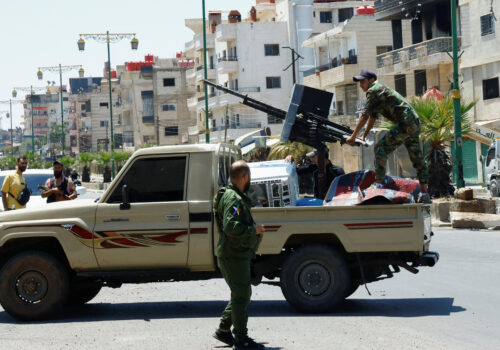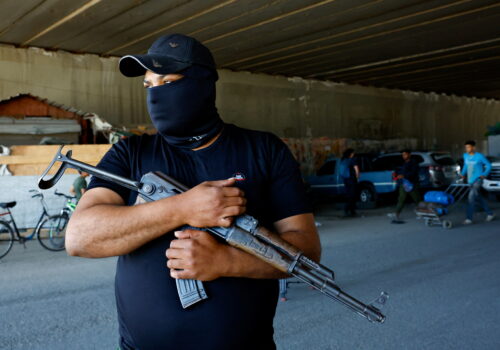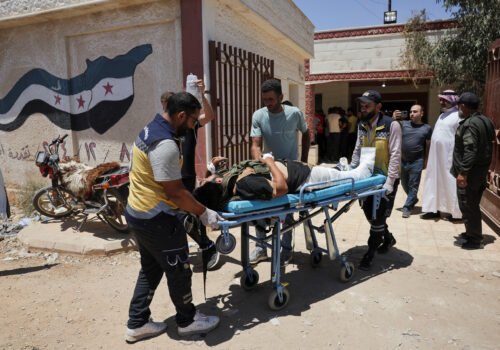Sweida’s humanitarian crisis presents a test for Syria’s transitional government and its global partners
Recent hostilities in Syria’s southern province of Sweida present a test for the country’s fragile political transition—and for the international community’s resolve to respond to the unfolding humanitarian crisis.
In July, deadly violence erupted in Sweida, a Druze-majority province that had largely remained on the periphery of Syria’s worst fighting since 2011. What began as clashes between Druze and Bedouin fighters in southern Syria quickly escalated into a political and humanitarian emergency. Syrian government forces were deployed to contain the crisis but began to withdraw following multiple Israeli strikes in Damascus, including a July 16 attack on the Syrian Ministry of Defense, which Israel stated were in defense of the Druze population.
After just over a week of fighting in July, more than 1,500 individuals—both civilians (including women and children) and armed actors—were killed, according to the Syrian Observatory for Human Rights. Several residents of Sweida had told Reuters that they saw rogue elements of the Syrian government forces participating in attacks on Druze fighters and civilians. While the cease-fire has been in effect since July 19, displacements continue amid persistent insecurity and widespread fear, as well as destruction of basic services. And earlier this week, new clashes between armed groups and Syrian security forces resulted in at least an additional death and have since put strain on the cease-fire.
Throughout the past month, images of decomposing bodies in an outdoor morgue, hospital corridors filled with wounded civilians, and families fleeing for safety have shaken Syrian society as well as the international community, both of which are closely watching the transitional government led by interim Syrian President Ahmad al-Sharaa. To protect the progress the interim government has made toward peace—and to keep these local grievances from triggering further regional instability—the United States and other international partners must act.
A two-fold humanitarian crisis
Impacts on civilians—both Druze and Bedouin—have been substantial, as both communities have found themselves caught in the crossfire of escalating violence. The result is a two-fold and deeply fragmented humanitarian crisis. Furthermore, the Israeli strikes have introduced a new dimension to the conflict, reinforcing patterns of regional instability. These developments underscore how local unrest, such as the escalation in Sweida, can intersect with broader geopolitical dynamics.
The United Nations (UN) estimated that as of August 5, over 191,000 people—over a third of Sweida governorate’s population—had been displaced. Half of this group remains within Sweida’s borders, particularly in the Salkhad and Sweida districts. Hundreds of Bedouin families who were trapped in Sweida since the onset of the violence have been evacuated by the Syrian government, with over an estimated 1,500 people having moved to Daraa and rural Damascus.
Even before the recent clashes, two-thirds of Sweida’s population relied on humanitarian aid—an enduring effect of the last decade and a half of conflict in Syria. Civilians have since faced chronic power and water outages, the burning and looting of their homes, as well as shortages of medicine, fuel, and food. Health services, already limited, continue to be overwhelmed. The World Health Organization confirmed five attacks on healthcare professionals and infrastructure in Sweida in July, including the killing of two doctors, obstruction and targeting of ambulances, and temporary occupation of hospitals by armed groups—events which harken back to some of the darkest periods of the Syrian conflict.
Among the most jarring news was a Syrian Arab News Agency report, citing the Ministry of Defense, that hospital rooftops were being used by snipers from “outlaw groups” targeting government forces. At the same time, other reports, including one by the BBC, feature testimonies from hospital staff and volunteers who saw Syrian government forces attacking, and in some cases killing, Druze patients. These conflicting accounts underscore not only the brutality of the violence but also the deep confusion, fragmentation, and erosion of trust that now characterizes the humanitarian response in Sweida.
Politicization of aid
The days that have followed the clashes in July have revealed a deeply fractured and politicized humanitarian landscape, which directly affects the coordination and delivery of aid into Sweida province. Access to the city became heavily restricted, which led to allegations of a government-imposed siege on Sweida. However, Sweida’s governor, Mustafa al-Bakour, recently denied any allegations of a siege on Sweida city and the existence of obstacles to traffic movements or the entrance of humanitarian organizations.
Several humanitarian agencies—including the UN, the International Committee of the Red Cross, and the Syrian Arab Red Crescent—have reportedly managed to deliver much-needed aid to parts of Sweida province as well as populations displaced to Daraa and rural Damascus. However, the UN Office for Coordination of Humanitarian Affairs said on July 27 that access for these convoys remained constrained as intermittent violence led to roadblocks and a general sense of insecurity.
SIGN UP FOR THIS WEEK IN THE MIDEAST NEWSLETTER
Conversations I had with aid workers and civilians attempting to deliver relief reveal that these barriers are due to a chaotic patchwork of access permissions from local power brokers and armed groups. As one aid worker reported, “Sometimes people go to the checkpoints and are allowed in. Sometimes they aren’t—it really depends on who is manning the checkpoint.” Syria’s Information Minister Hamza Mustafa claimed that humanitarian aid heading to Sweida has not stopped, while also pinning the blame for the shortage of supplies on “outlaws seeking to exploit our people’s suffering for their own purposes.”
At a July 29 event, Syrian Minister of Health Musaab Nazzal Al-Ali recounted how he and the country’s minister of social affairs and labor were at the head of a convoy on the second day of fighting, and they “were prevented from entering Sweida, and we received warning messages and were banned from entering.” He also talked about how, two days later, another convoy he accompanied was prevented from entering until the convoy was permitted to enter under the auspices of the Syrian Arab Red Crescent. This lines up with reports that community leaders in Sweida, such as Sheikh Hikmat Al-Hijri, have rejected aid channeled through the Syrian government, which they view as complicit in the violence.
As shown by these accounts, aid convoys, which should be neutral, were caught in a broader battle over political recognition. This ultimately delayed life-saving assistance, including bread and fuel, and exacerbated a crisis that is already deeply complex, multi-faceted, and politically charged.
That these aid convoys were turned away also signals a breakdown of legitimacy that extends far beyond policy disagreements and reflects a critical disintegration of command and control (even within the Druze community itself), as well as contention over who holds authority to allow aid through. They show that there is a crisis of trust and legitimacy in Syria’s transition and its state institutions. Aid delivery has become a political fault line in the larger debate over who is trusted to lead Syria’s recovery.
Progress on political priorities, whether through constitutional reform or international diplomacy, will be hamstrung by these unresolved local crises of credibility. That is because these crises, such as the one in Sweida, are emblematic of a wider legitimacy crisis.
Syrians across all communities experienced a Syrian state under the Assad regime as predatory or absent. The reported violence of rogue actors among the interim government’s security forces has only reinforced public perception that there is a long road ahead to rebuild trust and credibility in the new state. As interim Syrian authorities work to establish security and services across Syria, public trust is essential. Yet, as shown in Sweida, that public trust is at risk. Acknowledging this “draining trust,” Syria’s UN special envoy, Geir Pedersen, emphasized the need for “major course corrections on security and the political transition” in Syria.
The bottom line is that fractures in Syria’s fragile social contract have wider ramifications: Domestic collapse can lead to regional escalation, increasing the risk of a broader breakdown.
Priorities for US diplomats and policymakers
The United States and Syria’s international partners must act quickly, not only to prevent further bloodshed in Syria but also to advance progress that has been made toward peace and accountability. This is not about choosing sides in Syria’s complex sectarian landscape: It is about preventing a humanitarian catastrophe from metastasizing into regional instability.
On July 16, US Secretary of State Marco Rubio acknowledged the long-standing rivalry between the communities in Sweida, but made little mention of how the United States would strategically support the humanitarian response, especially given recent US foreign aid cuts.
First, Washington and other international partners (including UN agencies and international nongovernmental organizations) should facilitate unhindered humanitarian access, particularly in areas where Druze leadership controls access to aid. They can do so by supporting the interim Syrian authorities’ efforts to facilitate the delivery of aid—including trauma care, food, shelter, and non-food items—while simultaneously working to rebuild trust with local leaders through sustained, transparent, and community-led engagement. To do so effectively, the United States, as well as humanitarian actors including international nongovernmental organizations, must emphasize that humanitarian aid must remain neutral and apolitical. The focus must remain squarely on saving lives and restoring basic services, regardless of political or territorial control.
Second, Washington should use diplomatic pressure to push interim authorities in Damascus to reel in rogue members of the security forces—including any implicated in war crimes during the episodes in Sweida, Syria’s coast, or during the fourteen years of Syria’s civil war. Trust among all Syrian civilians, as well as Syria’s neighbors, in the new Syrian state will remain fraught in the absence of an accountable and professional military. As my colleague Ibrahim Al-Assil outlined, this includes encouraging regional stabilization talks, especially with Turkey, Jordan, and Arab Gulf states, to contain the fallout.
Third, Washington should continue to encourage Syrian interim authorities to make right their promises to pursue transparent investigations into violations in Sweida, including attacks on health infrastructure and civilian displacement, while amplifying the work of Syrian civil society in documenting abuses and calling for justice. The way recent massacres along the Syrian coast were brushed aside with little investigation or accountability does not bode well for how the violence in Sweida will be addressed, further deepening public mistrust in state institutions and reinforcing a pattern of unaccountability.
Sweida is not an isolated tragedy—it is a litmus test for Syria’s fragile political transition and for the international community’s resolve to respond to the unfolding humanitarian crisis. The Trump administration has often framed Syria policy around counterterrorism and containing Iranian influence, but the Sweida crisis reveals how the United States has a vested interest in ensuring localized grievances don’t unravel broader regional stability—undermining both regional security and long-term US strategic interests.
Diana Rayes is a nonresident fellow for the Syria Project in the Atlantic Council’s Middle East programs and a postdoctoral associate at Georgetown University’s School of Foreign Service.
Further reading
Wed, Jul 30, 2025
After Swaida: How Syria’s periphery is shaping its future
MENASource By Ibrahim Al-Assil
What comes next in Syria will not be determined by battlefield victories or summit declarations, but by the evolving realities on the ground.
Thu, Jul 24, 2025
In a sectarian Syria, the winners should refrain from taking all
MENASource By Marie Forestier
To avoid the complete supremacy of HTS-supporting Sunnis, it is crucial to adopt power-sharing mechanisms ensuring inclusiveness
Tue, Jul 22, 2025
Why the violence in my hometown, Swaida, goes beyond ‘rivalry.’
MENASource By
US officials described the events as “a rivalry” between Syria's Druze and Bedouins. But this framing strips the crisis of its historical and political context.
Image: People stand next to a destroyed tank turret, following deadly clashes between Druze fighters, Sunni Bedouin tribes and government forces, in Syria's predominantly Druze city of Sweida, Syria July 25, 2025. REUTERS/Khalil Ashawi TPX IMAGES OF THE DAY



